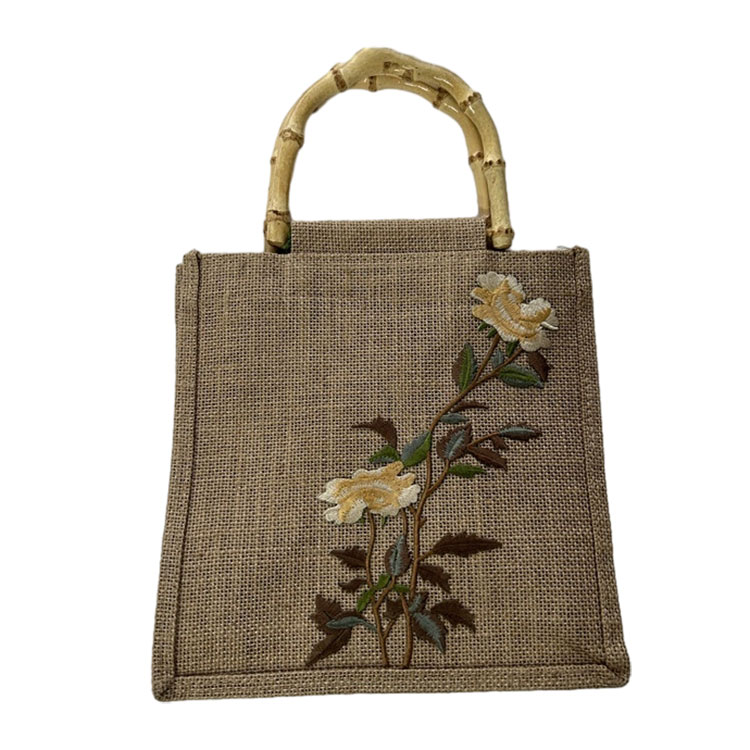
- English
- Español
- Português
- русский
- Français
- 日本語
- Deutsch
- tiếng Việt
- Italiano
- Nederlands
- ภาษาไทย
- Polski
- 한국어
- Svenska
- magyar
- Malay
- বাংলা ভাষার
- Dansk
- Suomi
- हिन्दी
- Pilipino
- Türkçe
- Gaeilge
- العربية
- Indonesia
- Norsk
- تمل
- český
- ελληνικά
- український
- Javanese
- فارسی
- தமிழ்
- తెలుగు
- नेपाली
- Burmese
- български
- ລາວ
- Latine
- Қазақша
- Euskal
- Azərbaycan
- Slovenský jazyk
- Македонски
- Lietuvos
- Eesti Keel
- Română
- Slovenski
- मराठी
- Srpski језик
What are the typical design elements of linen handbags
2025-10-14
Linen handbags have become a popular fashion item among many consumers due to their natural environmental friendliness, good breathability, and unique texture. In terms of design, linen handbags usually combine the characteristics of their natural materials and incorporate various design elements to create products that are both practical and aesthetically valuable. Here are some common design elements for linen handbags:
1. Minimalist style
Simple lines and contours: Linen handbags typically adopt a minimalist design style to avoid overly complex decorations. Simple lines and simple shapes are often its main features, making the bag highly adaptable in appearance and suitable for various daily occasions.
Single color or natural tone: The linen material itself presents a natural beige, gray, brown, or light yellow isothermal and tone, and many linen handbag designs will retain these natural colors, highlighting the texture of the material itself.
2. Environmentally friendly materials and details
The combination of linen and leather: Although linen is a natural and environmentally friendly material, designers often combine it with other environmentally friendly materials such as leather, cotton, or canvas to increase the durability and texture of the bag. For example, leather handles or the bottom of a bag are made of leather material, making the bag more sturdy and durable.
Natural Decoration: Some linen handbags incorporate natural elements such as shells, wooden beads, and rattan as decoration, enhancing the natural and environmentally friendly style and creating a unique handmade feel.
3. Multi functional design
Adjustable shoulder straps: Many linen handbags are designed in a shoulder back form with adjustable shoulder straps, providing more usage scenarios. Especially suitable for consumers who prefer a comfortable and lightweight style.
Folding design: Some linen handbags feature a foldable design for easy storage, making them suitable for travel or shopping.
Multiple pockets or compartments: To enhance practicality, designers will add multiple pockets or compartments inside and outside the bag for convenient storage of small items such as mobile phones, wallets, keys, etc.
4. Patterns and Embroidery
Hand embroidery: Some linen handbags are designed with exquisite embroidery patterns to enhance the artistic and handmade feel of the bag. Common embroidery patterns include plants, flowers, animals, or abstract geometric patterns.
Printing design: In addition to embroidery, printing is also a common design element. Designers often use unique printing patterns on linen handbags, such as ethnic style, geometric patterns, bohemian style, etc., to give the bag a personalized appearance.
5. Matching of natural materials
Hemp rope or wood decoration: Some linen handbags use hemp rope or wood as handles to enhance the overall natural atmosphere. As a handle, hemp rope not only conforms to the natural characteristics of linen material, but also creates a relaxed vacation style.
Rough texture: The natural rough texture of linen fabric is also a major highlight in design. Many designers choose to maintain the original feel of this texture, avoid excessive decoration, and emphasize the unique charm of the material itself.
6. Geometric shapes and unique contours
Geometric shape: Some linen handbags adopt modern geometric shapes such as circles, squares, or triangles, breaking the traditional design of handbags and forming a unique visual impact appearance.
Irregular silhouette: In order to be more creative and artistic, some linen handbags may have irregular shape designs, which not only have unique beauty, but also attract consumers' attention.
7. Sustainable development and multi-purpose design
Recyclable materials: Many designers focus on the environmental friendliness of bags and choose recyclable linen fabrics or engage in recycled design, advocating for sustainable fashion concepts.
Folding or multifunctional use: Some linen handbags adopt a multifunctional design, such as being able to be turned into shopping bags, picnic bags, etc., to meet different living needs.
8. Comfort and Convenience
Comfortable handle: Designers pay attention to the comfort of the handle and often choose widened, thickened, or soft handles to avoid discomfort during long-term use.
Lightweight design: Linen itself is a lightweight material, so the design emphasizes convenience and lightness, suitable for daily commuting, travel, or leisure use.
9. Exquisite sewing techniques
Hand sewn: Some high-end linen handbags use exquisite hand sewn techniques, which not only ensure the quality and durability of the bag, but also add a unique artistic atmosphere to it.
Symmetrical or asymmetrical stitching: The stitching design of bags can sometimes become a visual highlight, with some designs choosing symmetrical stitching while others choose asymmetrical stitching to increase fashion sense.
10. Color matching
Neutral colors and natural tones: Linen handbags are often dominated by neutral or natural tones, such as beige, gray, khaki, etc. These colors complement natural materials, are simple and elegant, and suitable for various combinations.
Contrastive colors or bright color schemes: Some designers like to use contrasting colors or bright color schemes to embellish their bags, such as bright red, blue, green, etc., to make the bags look more vivid and interesting.
In summary, the design elements of linen handbags usually revolve around nature, environmental protection, simplicity, and practicality. Designers will incorporate embroidery, printing, geometric shapes, and other elements based on the characteristics of linen fabric to create products that are both visually appealing and meet functional requirements. It is not only suitable for daily use, but also meets consumers' needs for fashion, environmental protection, and versatility.





